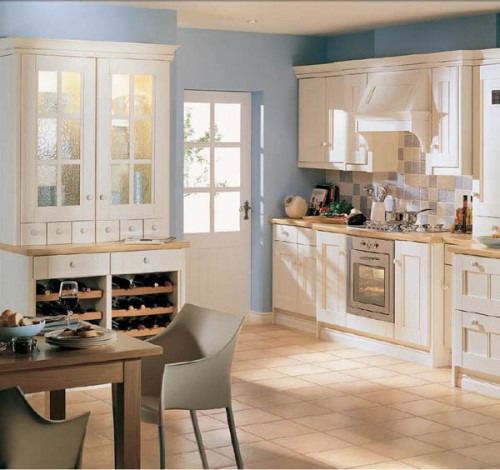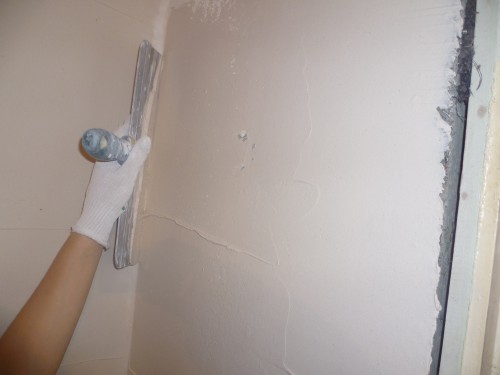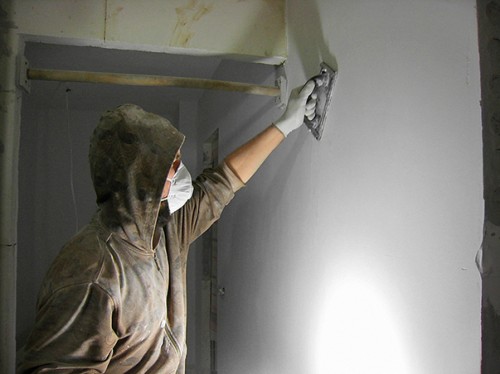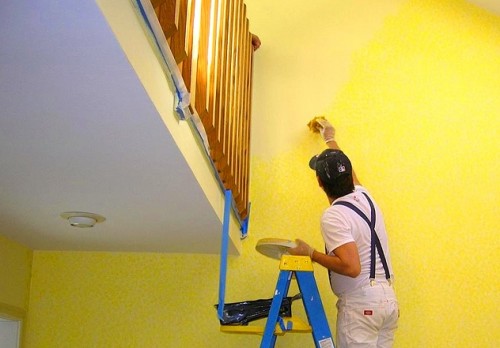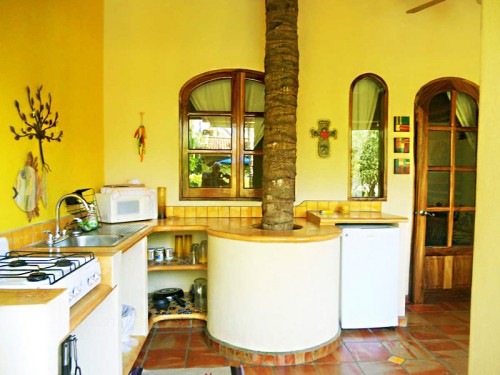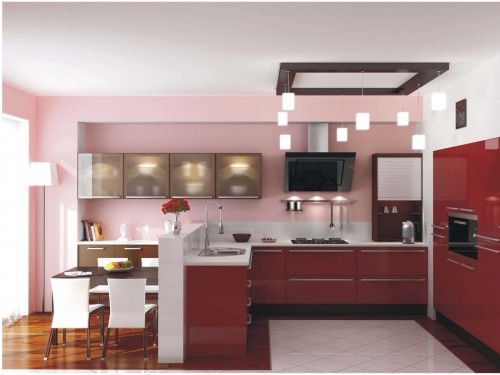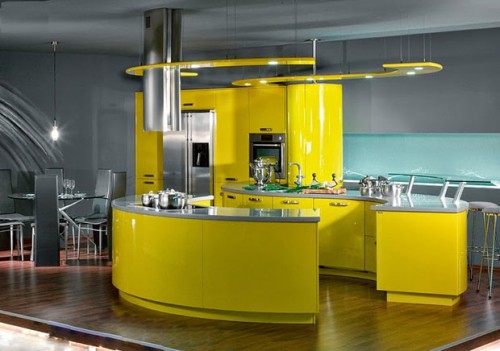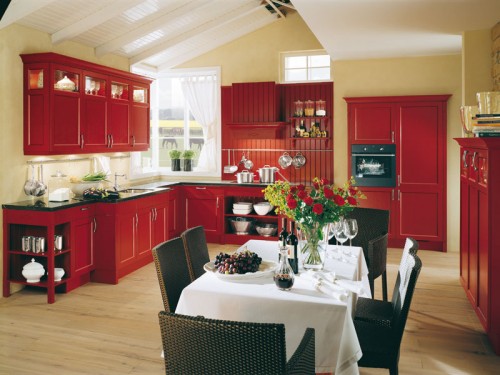In modern interiors, wallpaper and tiles in the kitchen have faded into the background. They are replaced by smooth surfaces of the kitchen walls, acquiring a beautiful gradient by lighting. The choice of colors and shades for painting is truly limitless. Such walls will successfully emphasize modern furniture, it is easy to refresh them and repaint them. Consider the features of choosing a color scheme, materials for painting walls, as well as process technology.
Content
Varieties of paint for kitchen
Paint is an affordable material that makes it possible to choose any shades and combinations depending on the interior style. When choosing it, it should be borne in mind that such parameters as water resistance, environmental friendliness, the ability to “breathe” are important for decorating the walls of the kitchen. It is desirable that the painted wall is detergent, not susceptible to rapid burnout.
Glossy paints meet many of the stated requirements - they are waterproof and wash well, but all errors and irregularities are clearly visible on their surface, the wall for such paint should be perfectly smooth. Matte and semi -water varieties will perfectly hide irregularities, but the surface will absorb dust and kitchen pollution.
Many experts recommend choosing water -based paints for kitchen walls.
There is the following selection of materials for painting the kitchen:
- water emulsion paint - differs in many advantages (quickly dries, there is no pungent odor, environmentally friendly and not allergenic, creates opportunities for creativity - you can independently compose shades by adding color pigments to the base). In any paint store, you can easily choose the desired shade of the walls according to the catalog, at home it will only have to dilute the paint with a pigment in the desired proportion and stir. It is easily washed off hands and tools, while the use of a solvent will not be needed. Experts recommend water -based paints of several types for kitchen walls and ceiling, depending on the composition (acrylic - including with the addition of latex, silicate and silicone);
- alkyd (oil) paint - is made on the basis of alkyd resin and olifa, which give the composition strength and elasticity. It has high moisture resistance and resistance to chemical influences, it is perfectly washed, does not burn out, easily applied and does not shrink. To dry oil, it will take at least 12 hours, at this time it is necessary to provide ventilation in the room;
- epoxy and polyurethane paint - due to the presence of appropriate resinous substances in their composition, form wear -resistant and durable coatings, are resistant to moisture and chemical influences, as well as a fairly high price.
Choosing the color of the kitchen walls
First of all, the design of the interior of the kitchen, like any other dwelling, depends on the personal tastes of the owners, their color addictions, the desire to bring a certain mood to your house. It will also be important to select a combination of wall painting with an existing room style, kitchen furniture and other interior items.
When choosing design of the walls of the kitchen, you can use the following designer recommendations:
- the kitchen furniture of the classical style will look great against the background of the walls of calm peach, beige, milk color;
- the contrasting finish is well suited for white furniture - for example, intense turquoise, plum. This rule also works on the contrary - against the background of white walls, the furniture of saturated shades will look good;
- if you want to combine several different colors in the kitchen interior, then designers advise combining the walls and a kitchen set in one color scheme, and distribute other colors in other details of the interior (facing tiles, floor, dishes, etc.);
- to give the kitchen room a romantic atmosphere, you can choose a color solution to furniture and walls in pastel colors;
- warm tones (light shades of yellow and orange) will arouse appetite, and cold is suitable for those who want to lose weight;
- in the case of choosing warm colors, it is recommended to use shades adjacent to the color palette;
- for a visual increase in space, light pastel colors are suitable;
- based on the illumination of the kitchen - if the room is sunny, then too bright colors will look sharply, or even completely change the shade. The slightly lit room is not recommended to be decorated in dark colors;
- the location of the kitchen should be taken into account - for the north side it is recommended to use warm colors in the interior, and for the southern - cold shades.
The well -thought -out color scheme of the kitchen interior will contribute to the creation of the atmosphere of comfort in everyday life.
Preparation of the walls of the kitchen for painting
For painting walls in the kitchen, the following tools and materials may need:
- spatulas (wide and narrow);
- wall painting roller, painting brush;
- deep penetration fluid;
- putty (starting and finish);
- maular glasshold (web);
- mARAL SIGN (adhesive tape);
- grinding skin of medium grain;
- capacity for dye (bank, painting bath or pallet);
- rubber gloves - will protect when working with aggressive chemicals (protective glasses may also be needed);
- paint for walls.
It is necessary to apply the paint to the purified and even prepared surface. To do this, you need to remove the old finishing materials from it - wallpapers, lime whitewashing, and remains of paint. In order to easily remove old wallpaper from the wall, you can use a roller soaked with warm water. It is necessary to remove the spots of kitchen pollution, rust, flow. If there are molds and fungus on the walls, then such spots should be cleaned with a metal brush, and then treat these areas with anti -inflicted drugs.
Next, you need to do the following preparatory work:
- Wipe the potholes and cracks with a sand-cement mortar or sealant.
- Process the surface of the walls with a primer (recommended in two layers).
- To align the surface, it is necessary to apply a starting coarse -grained putty on the walls.
- Before the final putty, we apply the so -called “masking web” (fiberglass grid) for reinforcing and strengthening the surface - this will help subsequently avoid cracks on the walls.
- After drying the previous layer, we apply the finish fine -grained putty for final leveling, after which you need to clean the dried surface with a skin and primed the walls.
The primer of the surface of the walls allows:
- increase the adhesive properties of the surface, i.e. create prerequisites for further good adhesion of walls and paint;
- protect against moisture;
- prevented and cracking, as well as the appearance of stains and stains.
The use of a deep penetration primer is recommended. For a small kitchen, up to two liters of primer will be required, it is allowed to breed it with water in a proportion of 1: 1.
Wall painting in the kitchen
After preparing the surface for painting, you can begin directly to the application of the coloring composition to the walls. It will take several times (at least two, and sometimes three) to paint the walls. The number of layers depends on the consistency and the quality of the selected paint. Carefully read the recommendations of manufacturers of the material used.
To achieve even lines during painting and maintain the surface of the ceiling clean, it is recommended to glue the joints from the wall with masking tape.
When painting the walls of the kitchen, the following nuances should be taken into account:
- to exclude the appearance of the drones, use the painting pallet - with the help of its ribbed edge it is convenient to remove excess paint from the brush;
- it is recommended to start painting the walls from the window;
- for the first layer of paint, it is allowed to dilute with water by 15-20% (carefully study the manufacturer's instructions);
- initially, the corners and inaccessible places are stained with a masking hand, and then with the help of a roller they begin to paint the surface of the wall;
- they move to the next wall after a complete application of the paint layer to the previous one;
- a new layer of paint must be applied after the previous one is completely dry;
- it is recommended to apply the paint in different directions a layer behind the layer (from left to right, then from the bottom up), and then shave out - thus, the paint is evenly distributed without strokes along the surface of the walls.
Wall painting in the kitchen - photo:




